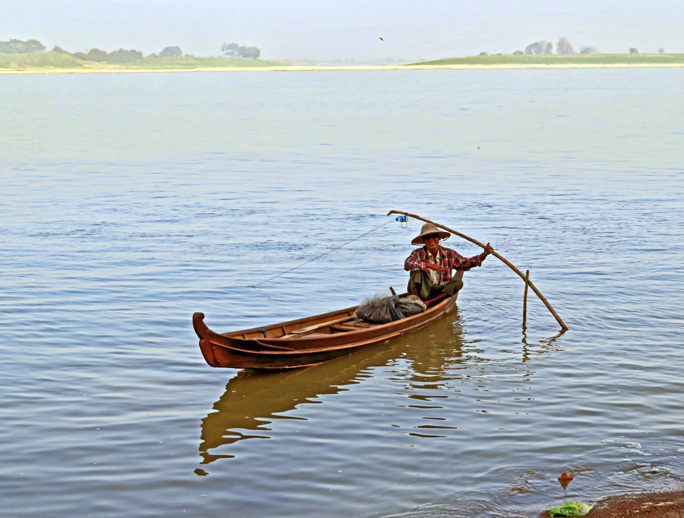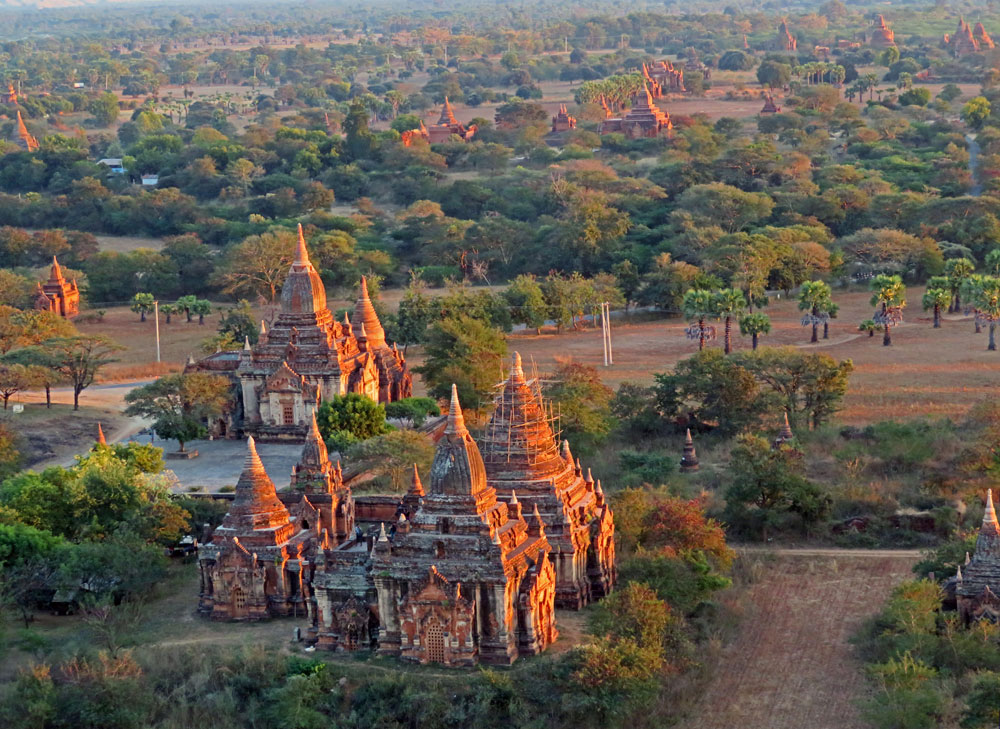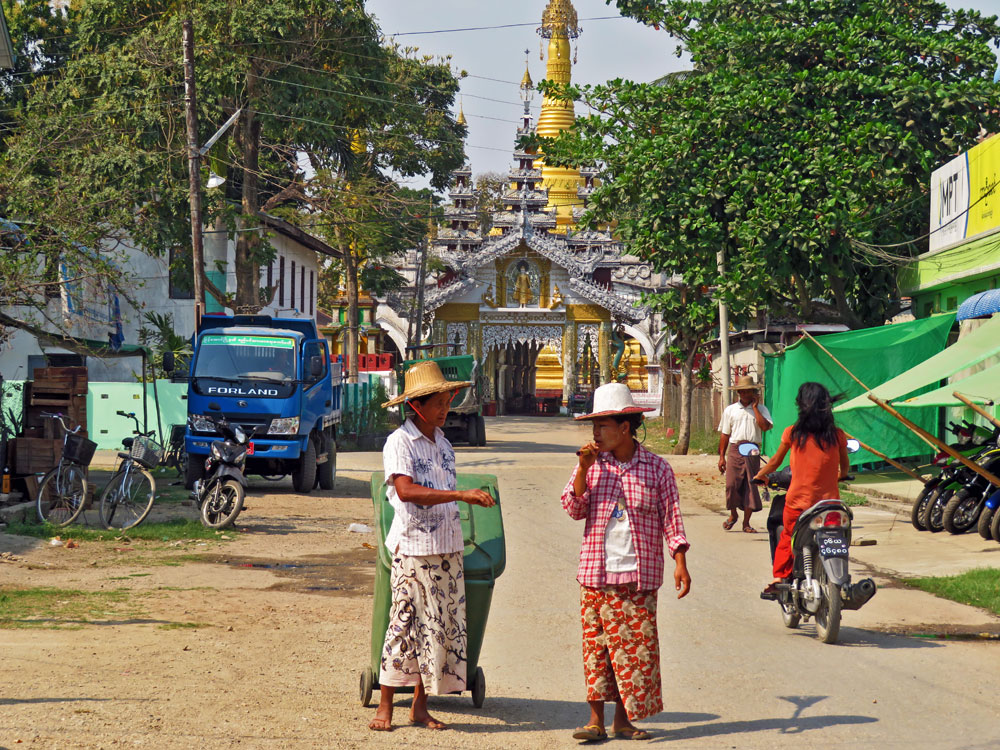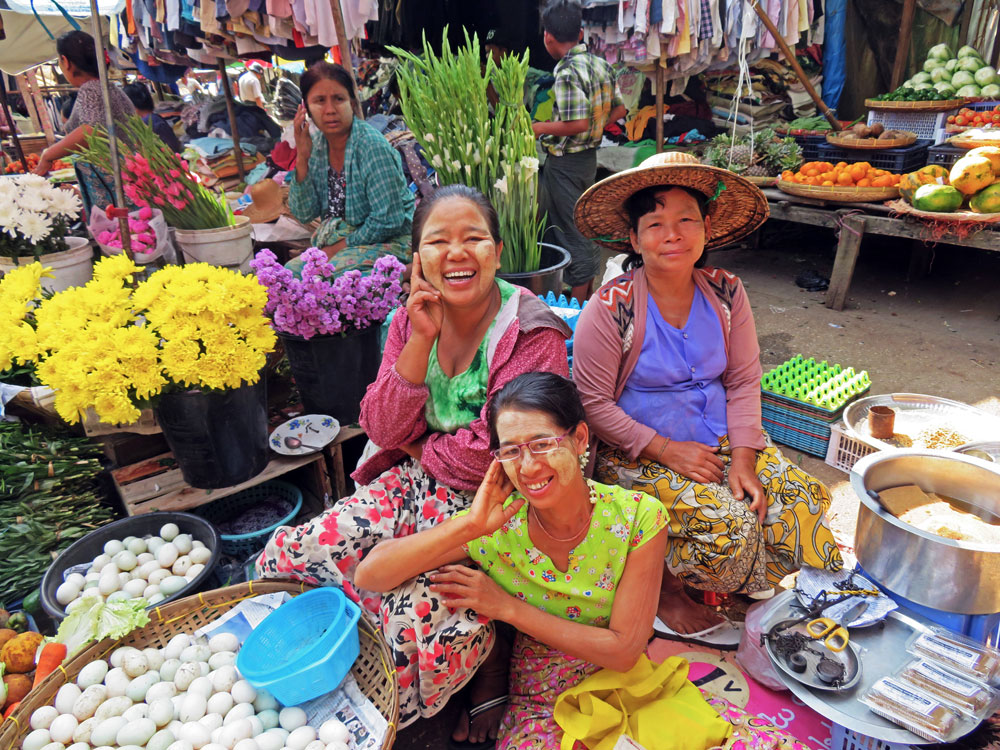
Myanmar is poor in terms of per capita income but abundantly rich in natural resources and human warmth.
It’s still a handsome house, but it must once have been quite beautiful. Its large ornate portico would have provided protection from the Burmese rains and the tree-shaded verandahs would have been a cool refuge during hot Rangoon summers. In this, my grandfather’s house, I was born in 1946, and here I might have died while still a baby.
I lived because of Clement Attlee, Prime Minister of Great Britain (1945-51).
In 1946, General Aung San, a fervid nationalist, had been appointed leader of Burma by the ruling British. The following year, he travelled to Britain to petition for Burmese independence.
Fortunately, Attlee agreed. According to the BBC documentary titled Who Really Killed Aung San? had he refused, Aung San had a contingency plan – an armed rebellion with the killing of all the British and their families in the country at the time. My father, a British officer, was helping with the post-war reconstruction in Burma. He, my mother, and I would undoubtedly have been among the slaughtered.
But I knew none of this before I came to Burma, a rich and largely underdeveloped country now known as Myanmar. I watched that BBC documentary on the river boat, Amapura, which took us from Mandalay to Yangon (formerly Rangoon) along the Irrawaddy River. This AmaWaterways cruise was to have been a chance to really see the country of my birth, if not of my nationality. Would I feel a tug?
Our starting point, Mandalay, was once a royal capital, and it perfectly set the stage for our journey through this extraordinary country with its strong Buddhist roots. In Mandalay, we visited the first of many shrines, the Mahamuni Temple. One of Burma’s most sacred sites, it is said to hold an image of Gautama struck during his lifetime. Here too, is the Kuthodaw Pagoda. Built by King Mindon in 1857, its splendid golden stupa is surrounded by the ‘world’s largest book’ – 729 large upright stone slabs on which are inscribed Theravada Buddhist scriptures. It was an impressive start to more than 15 days of slow progress down the river.
For the Burmese, the Irrawaddy River is a laundry, bath, source of food, and major transportation route. Like the Salween and the Chindwin rivers, it starts high in the mountains, meandering south through teak and mahogany forests, and around mines producing jade, sapphires and world famous ‘pigeon’s blood’ rubies.
The Amapura was just one of many vessels plying the narrow river. Most are much smaller, busily fishing or ferrying people between villages. While our ship was undoubtedly grand, I positively coveted an opportunity to ride in what I called the egg beater. This narrow boat features a long oar at the back, tipped with a tiny motor which looked and sounded like my name for it.
Though it holds just 50 guests, the Amapura is huge in comparison. And while it features modern depth sounding equipment, the captain, Du Maw, posted a man with a very long stick on the bow. At regular intervals he carefully poked the stick deep into the water. “It’s the traditional method,” the Burmese captain smiles when we comment on his assistant’s activities. “It is the end of the dry season, so the water is very low. I do not want to run aground.”
We stopped at important tourist cities like Bagan, Sagaing, and Pyay, as well as at tiny villages like Da Ny Phyu, only accessible by boat. At each small village, we gave gifts of food to Buddhist monks and nuns. With the encouragement of locals, we practiced our halting Burmese phrases at colourful markets. We played and sang songs with children, and listened with delight to the Burmese version of If you’re happy and you know it, clap your hands! And we paced, shoeless, through the grounds and up the steps of magnificent, golden pagodas and shrines.
In terms of per capita income, Myanmar is the poorest country in Southeast Asia, but its population supports – and daily feeds – more than half a million Buddhist monks as well as nearly 100,000 nuns. The majority of males in the country spend some time in a Buddhist monastery, often starting as young as age six. Each morning, maroon-robed monks wander the streets and markets with their distinctive alms bowls asking for food. For Burmese Buddhists, the path to being reborn into a higher state includes good deeds and merit through charity, so monks are never refused.
Probably nothing demonstrates the strong faith of these people like the ubiquitous pagodas. Even the smallest and poorest village will have at least one, their golden domes often standing in sharp contrast to the surrounding poverty.
On the Bagan plain, located southwest of Mandalay in central Myanmar, between the 11th and 13th centuries, 10,000 Buddhist temples, pagodas and monasteries were constructed by various faithful Buddhist rulers. The most magnificent of these is the Ananda Temple which our guide cheerfully described as the “Westminster Abbey of Burma”. Inside, four enormous golden Buddhas face the cardinal points. At more than 30-ft. tall, these dwarf the visitors who come to pray, instantly creating a sense of awe.
Time and earthquakes have taken their toll on Bagan’s stupas. Today, only about 3,000 still remain, standing like quiet sentinels over the dry landscape. At sunset, when the dust reflects the red-gold rays of the setting sun, the effect is awe-inspiring.
At each holy place we visited, our guide would announce, “Shoes off!” and we all dutifully complied. I even climbed – shoeless – the 777 steps to the Buddhist monastery atop Taung Kalat (often called Mt. Popa), a sheer-sided volcanic plug, which rises impressively 2,156 ft above sea level. En route, I scattered peanuts to the cheeky macaque monkeys who make their home here and demand treats of pilgrims. The trip earned me a beautiful view of silent stupas dotting the landscape of Bagan at sunset, a few sore muscles the next day, and most importantly, the Buddha’s blessing.
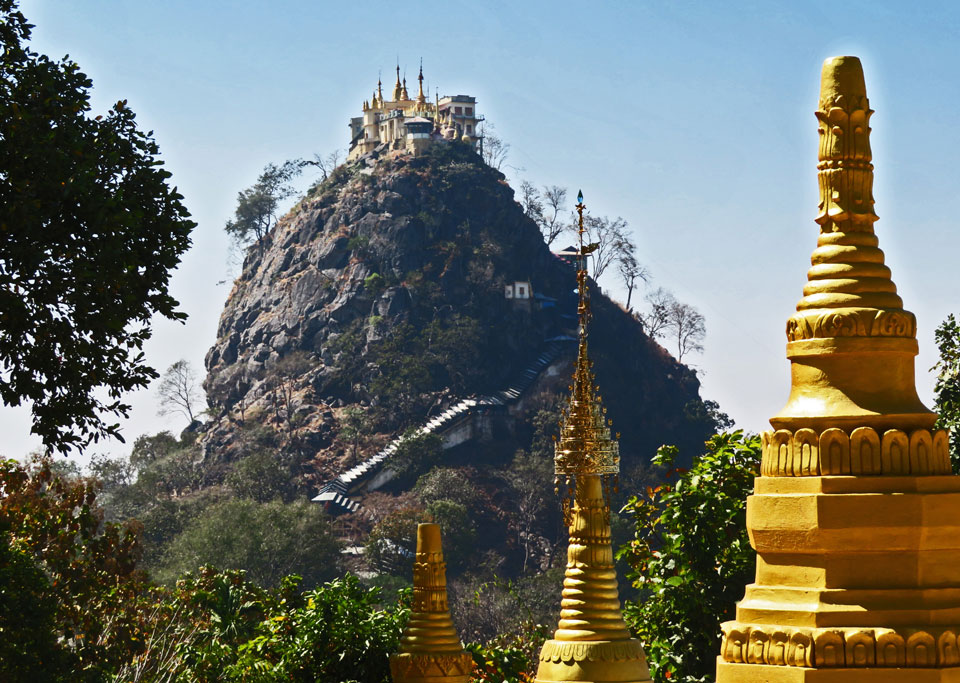
The best view of the Bagan Plain comes from Taung Kalat Monastery atop 2,156-ft. Mt. Popa. Start climbing the 777 steps early so you’ll be there at sunset when the temples below glow reddish gold because of dust in the air.
The next day in Minbu, I bought more good karma by throwing milk and popcorn into a bubbling mud pit. Legend says these offerings pacify the fire-breathing dragon which lives beneath the mud, though no one could explain why popcorn and milk are particularly efficacious. Informed that this area has huge deposits of natural gas under the ground, I bravely put my hand into the mud to ‘pat the dragon’. My courage drew looks of admiration from the onlookers and gasps of wonder when a large bubble burst to the surface immediately afterwards. A sigh of contentment?
Probably the most remarkable example of the faith in this country is Customs Hill. Here, where the Irrawaddy narrows as it approaches Rangoon, the British collected taxes from boats bringing goods to the capital city. Often having to wait for several days for their turn to be assessed, the boatmen spent their time carving enormous Buddhas into the cliffs along the Irrawaddy River as a prayer for good fortune (and perhaps a lower levy?). These dozens of carefully carved and painted figures can only be truly appreciated from the water, as they decorate an extensive stretch of cliffs alongside the river. I can’t help but compare the Buddhist version of graffiti to our own!
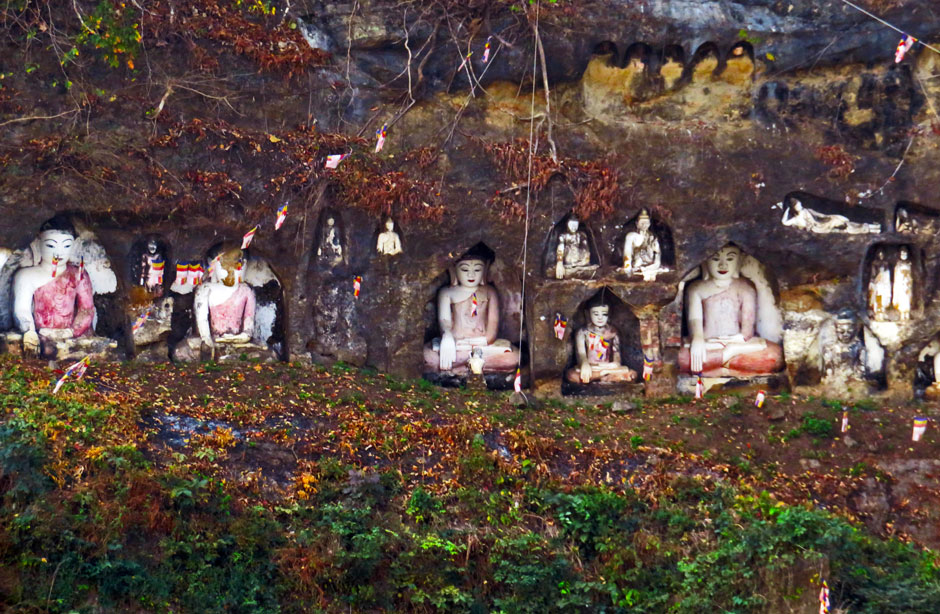
Buddhas carved and painted more than a century ago by Irrawaddy boatmen waiting to pay taxes still look down from the Customs Hill cliffs high above the river.
The British and their tariffs are long gone. Burma was closed to the world for decades, run since 1962 by a military junta. They have been – and continue to be – responsible for some appalling atrocities. Yet everywhere, the people we encountered appeared charmingly unworldly and kind. If I forgot my change, someone would run after me to return it. And more than once, a smiling market lady, seeing my curiosity, would offer to share her lunch with me. I found myself pleased to think I was born into such a friendly world, and that my first contact with it was my Burmese nanny, Rosie. Rosie remained with our family long after we left the country.
Near Minbu is Magwe, the birthplace of General Aung San, the very man who would have initiated the rebellion in which our family might have perished. We arrived in time to join the crowds commemorating his birthday. Assassinated only a few months after winning Attlee’s agreement, Aung San is still venerated as the hero who won Myanmar their independence. His golden statue on horseback stands in Magwe’s main square. His daughter, Aung San Suu Kyi, gave up much to work for her country, (including her personal freedom for the 20 years during which she was under house arrest)
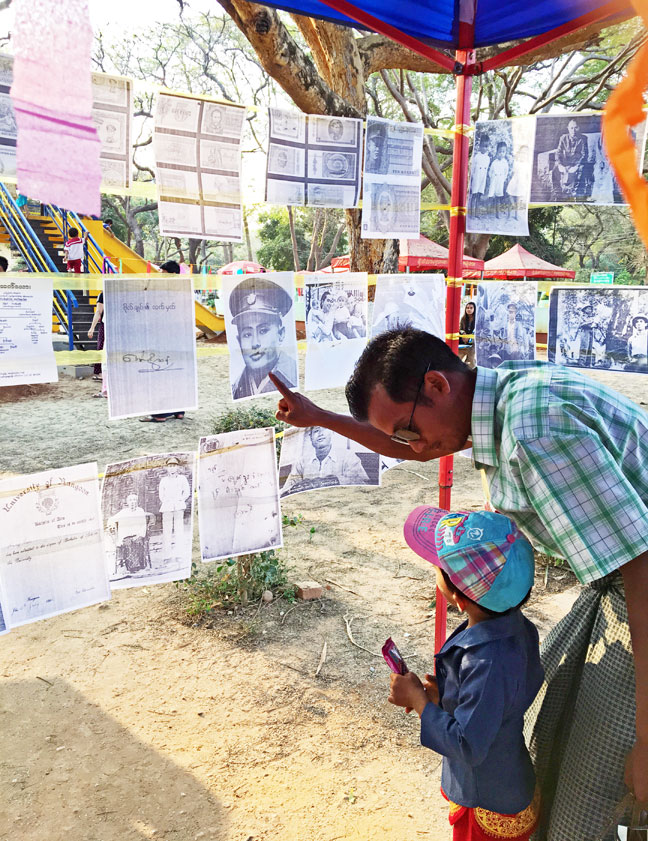
Burma’s founding father, Gen. Aung San, brought together numerous ethnicities into the Union of Burma, but did not live long enough to see his vision bear fruit. He and his daughter Aung San Suu Kyi remain cherished figures. A makeshift memorial in the town of Magwe provides a teaching moment for father and son.
The relentless sun shimmering on gold temples, the inevitable dust and sand at the end of the dry season, the difficulty of coping in a language so foreign to me that even after a week, I struggled with simple phrases – these are some of the impressions I took away after nearly three weeks in the country of my birth.
But finding my grandfather’s house sealed the experience.
A magistrate in India and Burma, my grandfather retained a home in Yangon until 1948. Much has changed since that time. Roads which once were dominated by horse-drawn buggies and rickshaws are today crowded with motorcycles, as well as cars and buses, most of which are designed to be driven on the right side of the road. But faithful to its British driving heritage, traffic stubbornly keeps to the left. I gasped when our minibus driver, sitting in the familiar left side of the bus, nonetheless veered to the left side of the road as we left the airport.
Even more disconcerting are the pedestrians, selling everything from peanuts to parasols, weaving in amongst cars stopped at the traffic light or in the ubiquitous traffic jams. My taxi driver bought a sweet mechanical monkey from one of these, for his son, he explained, proudly showing me a photo of the child.
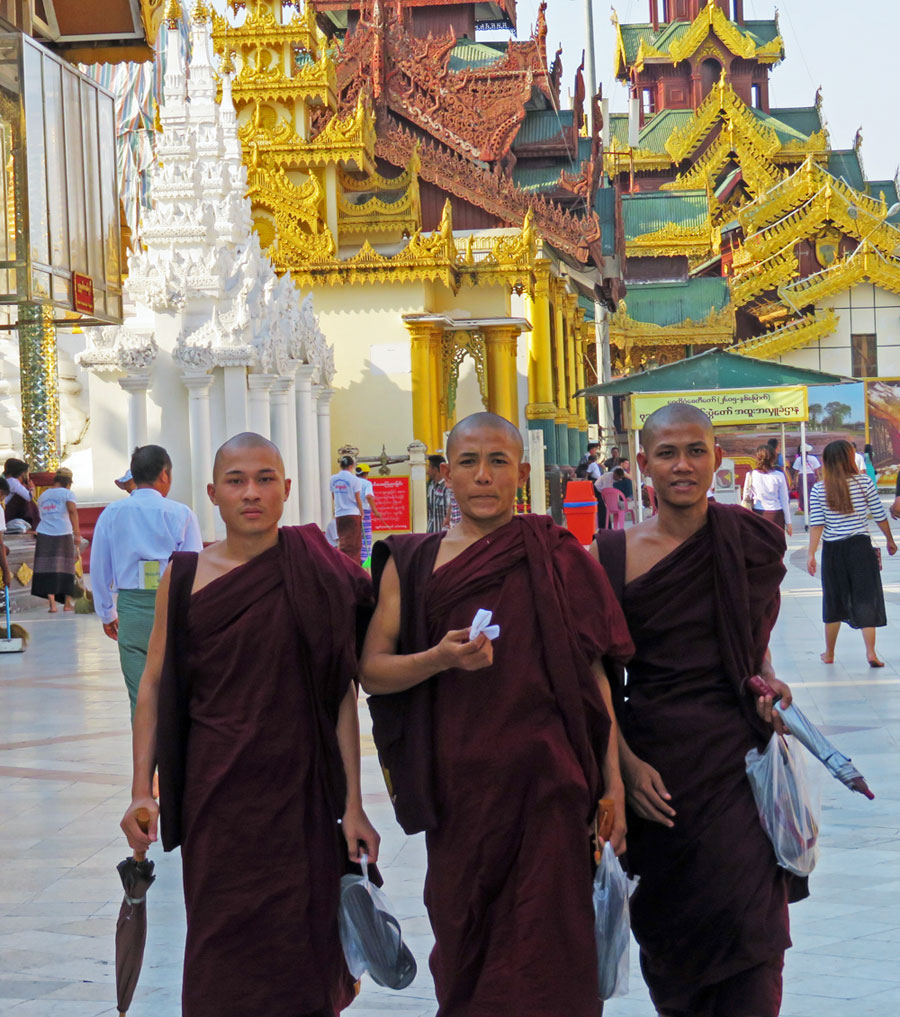
Young Buddhist monks stroll through a temple complex in modern Yangon, a city more romantically known as Rangoon.
The cityscape has changed but many of the old colonial structures, though crumbling now, still stand. Historic British built buildings like the Port Authority, the High Court building and the Secretariat, where Aung San was assassinated with several of his associates, are still in use.
While Buddhism predominates, Myanmar is a country of many religions. Everywhere one encounters whitewashed churches with soaring steeples; elegant mosques with decorated minarets; Hindu temples adorned with dozens of brightly painted figures; the inevitable gold-domed Buddhist temples; and one rather unique Jewish synagogue. Maintained by Sammy Samuels and his sisters, the synagogue is listed by Trip Advisor as one of the 10 top attractions of the city. Today, Sammy told me, there are just 20 remaining members of the community in the country.
The opulent Strand Hotel was built in 1901 by the Sarkies family, who also built Raffles in Singapore. The handsome hotel still retains its Victorian grandeur, and as has been done for decades, in the lobby guests are greeted by a musician playing the pattala, a Burmese xylophone style instrument.
Our budget being more limited, we stayed at Winner Inn, a comfortable, family run hotel, not far from the Shwedagon Pagoda. From here, we set about trying to find 28 Golden Valley Road – my grandfather’s house – in this city of more than four million people.
The road didn’t exist on any maps. A dead end? But our efforts at securing the Buddha’s blessings had apparently proved worthwhile.
A helpful local told me that the road does indeed still exist; the name was simply translated into Burmese. What’s more extraordinary is that 28 Shwe Taung Kya proved to be a 15 minute walk from our hotel. As we walked along the busy main road, my heart was pounding. But as we turned onto Shwe Taung Kya, it sank. Most houses on these large lots were modern. Number 28 was near the end of the road and my heart sank further; we faced a stone walled property with locked gates. Inside we could just see another modern looking house.
But once more, Buddha or serendipity intervened in the form of Sean Beesley, a passing teacher from the International School Yangon, which happens to be right next door. He stopped his bicycle and kindly asked, “You look lost, can I help?”
I described the house and mentioned the only other information I had. During the Second World War, it was occupied by the Japanese commander in Burma.
Sean’s face lit up. There was a house in the school compound right beside this wall, he said, and it had indeed been occupied by the Japanese. Of course, we couldn’t enter the school grounds, as many embassy children are students here and security is understandably tight. But Sean kindly offered to take us in.
And there it was – grandfather’s house!
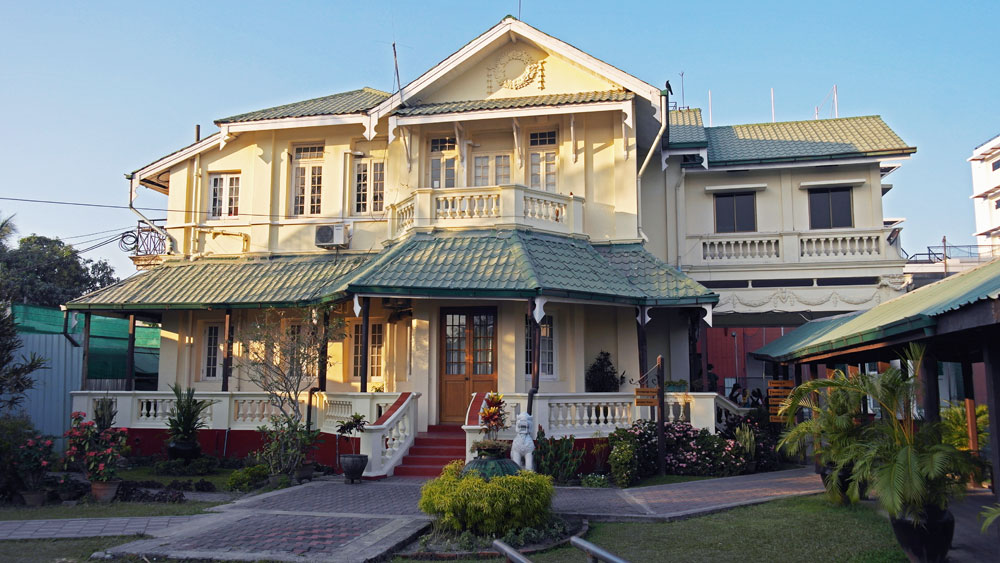
The British colonial house where I was born and spent the first few years of my life has changed but still stands despite rain, neglect and World War II.
A room had been added over the ornate portico, the teak ceilings had been painted white, and the teak floors covered in linoleum, but it was essentially as my mother had described it. She had even described the bedroom doors. The carved teak panels on the upper half of the pair of doors to each bedroom had apparently been removed by the Japanese when they departed; these were replaced with glass by the family after the war. Odd to think that some Japanese family might still have those carved teak panels in their home.
By a series of extraordinary coincidences, we had found the house into which I had been born! Amazing to think that this cool verandah with its red tiles might have been where my cradle had been rocked while I slept on a hot Rangoon day. And here I took my first uncertain steps as a toddler. My father was reassigned by the British army when I was just two, so I have no real memory of it.
In this city of more than four million people, I had four days to find the house, and on my last day, I had found it. And there it was – the tug.
That evening, I watched the sun set over the nearby Shwedagon Pagoda, the largest and most holy temple in Myanmar. It’s said to contain eight strands of hair from the head of Gautama. In its umbrella is a 64-carat African diamond, as well as hundreds of precious gems. Thousands come each evening to watch the dying rays of the sun light up its enormous solid gold stupa. It’s a wondrous sight.
Did I ever see this as a child and wonder at the glow? I don’t know, but I had a thrill at the thought. And the thought that perhaps this country had added some gentle Buddhist influence to my formative years. The next day I boarded a plane for home.![]()
Liz Campbell came to Toronto, Canada via Burma (now Myanmar), India, and England. She taught for two years with CUSO (a volunteer organization) in Tabora, Tanzania, and spent six months in Porto Alegre, Brazil. She has been a freelance travel and food writer for more than 20 years with stories published in The Globe & Mail, Zoomer, Foodservice & Hospitality magazine and more.


